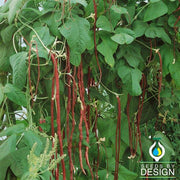Other Common Names: Asparagus bean, banor, cai dou, chang dou, chang jiang dou, chang kong tau, cheung kong tau, Chinese long bean, dau dua, dau gok, dau que, diya mekaral, dow gauk, garter bean, hamtak, jiang dou, juroku sasage mame, kacang belut, kacang panjang, kacang panjang hijau, kacang perut ayam, lobia, otok, sasage, sitao, sitaw, snake bean, tau afuk yaou, tau fug yao, thua chin, tseng dou, and yard long bean
How to Grow Red Noodle Bean
Red Noodle Bean seeds are direct sown in the late spring or summer after the last frost in a warm, sunny spot. Sow indoors 2-3 weeks before outdoor planting for an earlier harvest. Be sure to harden off well if indoor sowing. Plant in waves every 3-4 weeks for multiple harvests if you live in a warm climate. Keep soil moist in the early days. Fertilization might not be needed at all. Keep a close eye for spider mites if growing in a sheltered spot. Train the vines to climb strings or supports as they grow. Try planting arugula at the base and interplanting with bitter melon vines for increased pest resistance, quick growth, and efficient use of space.
Harvesting Red Noodle Bean
Harvest before 22” long. Best when about 12” long. Pods, seeds, stems, and leaves are all edible!
Culinary Tips
Yard Long Bean is used most notably in the popular Szechwan dish Dryfried Beans. These may replace string beans in any scenario. Pods can be deep-fried, stir-fried, steamed or used in soups. Prepare by cutting into 2" sections. Lightly steam the leaves and stems, then toss with olive oil for a nutritious side.
Tips From Our Gardeners
“Bean plants are already so fun to grow but Red Noodle Yard Long Beans are remarkable! I love growing them when children are around because you can literally watch the red bean pods grow up to an inch a day in certain climates.”






